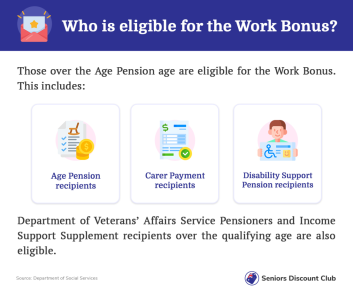New rules allow more pensioners to work and still keep their income support
- Replies 52
While the golden years of retirement are all about enjoying life at your own pace, let's face it – sometimes, you yearn to get back in the saddle.
Whether it's missing the hustle and bustle, seeking social interactions, or simply needing some extra cash, there are undeniable upsides to working post-retirement.
However, for many pensioners considering a return to work, the fear of losing access to income support has been a significant deterrent. The good news is that it appears the government is poised to change this!
Pensioners who wish to rejoin the workforce can now do so with far less worry about losing access to their income support, thanks to two significant changes introduced by the federal government in its new employment white paper.
To strengthen the workforce, the government has announced a permanent increase in the work bonus. This bonus allows pensioners to retain more of their pension while employed.
The nil rate period will also be extended from six to twelve fortnights. This means that all income support recipients, including those on JobSeeker, Youth Allowance, and the pension, will have double the time to receive income from a job before their government support is affected.
For those who may not be familiar with the Work Bonus, it incentivises pensioners over the Age Pension age to work, enabling them to retain more of their pension when they earn income through work.
But how does the Work Bonus impact pension rates?
The Work Bonus increases the amount an eligible pensioner can earn from work before it affects their pension rate. Specifically, the pension income test does not consider the first $300 of fortnightly income from work.
The Work Bonus operates alongside the pension income-free area. Effective from 1 July 2023, this area allows for $204 a fortnight for single pensioners and $360 a fortnight for couples combined.
What this means is that a single pensioner over the Age Pension age, with no other private income, could earn up to $504 a fortnight from work and still be eligible for the maximum rate of pension.
That being said, what is the Work Bonus income bank?
Pensioners who have reached the pension age can accumulate any unused portion of the $300 fortnightly Work Bonus concession amount in a special account known as the Work Bonus income bank. The maximum amount that can be accrued in this income bank is $7,800.
This income bank serves to offset future earnings from work that would otherwise be subject to assessment under the pension income test. There is no time limit for using the income bank, and any unused funds can be carried forward, even across multiple years.
The Work Bonus income bank proves particularly beneficial for pensioners who intend to engage in work, especially for those who take on intermittent or occasional employment.
Last year, it was announced that a temporary credit of $4,000 would be applied to Work Bonus income bank balances from December 1, 2022, to December 31, 2023. The maximum income bank balance would increase to $11,800 during this period.
However, pending the passage of legislation, this temporary measure is set to become permanent starting January 1, 2024.
All new pensioners over the Age Pension age will receive a one-off $4,000 credit to their Work Bonus income bank, and the maximum income bank balance will be permanently increased to $11,800.
Social Services Minister Amanda Rishworth said, 'We are removing the disincentive that sometimes might happen because a person might get offered some short-term work, but as a result may fear the loss of concessions… and indeed worried that if the work does not work out, they will have to reapply for JobSeeker.'
'So what this extension will do is allow someone to take up short-term work and still remain part of the income support system,' she explained.
'...allowing a smoother transition, to allow a person to take up short-term work and not feel there is a disincentive if that work does not continue.'
The changes are projected to cost $85 million through 2026-27, and they are aimed at removing the disincentive for pensioners to take up short-term work for fear of losing their government support.
Treasurer Jim Chalmers said the policy would help improve the workforce.
'This is about putting the right incentives in place to get more Australians into work,' Chalmers said.
'We want to make sure the stepping stones are in place to enable more Australians to take up a job or work more hours.'

So, to all our members considering re-entering the workforce or just looking to pick up some part-time employment to keep themselves immersed in the community, it seems like you'll have the chance to earn on the side and still continue to enjoy your pension and other support benefits.
As always, we'd encourage you to contact the relevant authorities to understand all the nitty-gritty details. For more information about the Work Bonus, Services Australia can be contacted by visiting a Centrelink office in person, by phoning 13 2300 or online at Services Australia.
What are your thoughts on these changes? Let us know in the comments below.
Whether it's missing the hustle and bustle, seeking social interactions, or simply needing some extra cash, there are undeniable upsides to working post-retirement.
However, for many pensioners considering a return to work, the fear of losing access to income support has been a significant deterrent. The good news is that it appears the government is poised to change this!
Pensioners who wish to rejoin the workforce can now do so with far less worry about losing access to their income support, thanks to two significant changes introduced by the federal government in its new employment white paper.
To strengthen the workforce, the government has announced a permanent increase in the work bonus. This bonus allows pensioners to retain more of their pension while employed.
The nil rate period will also be extended from six to twelve fortnights. This means that all income support recipients, including those on JobSeeker, Youth Allowance, and the pension, will have double the time to receive income from a job before their government support is affected.
For those who may not be familiar with the Work Bonus, it incentivises pensioners over the Age Pension age to work, enabling them to retain more of their pension when they earn income through work.
But how does the Work Bonus impact pension rates?
The Work Bonus increases the amount an eligible pensioner can earn from work before it affects their pension rate. Specifically, the pension income test does not consider the first $300 of fortnightly income from work.
The Work Bonus operates alongside the pension income-free area. Effective from 1 July 2023, this area allows for $204 a fortnight for single pensioners and $360 a fortnight for couples combined.
What this means is that a single pensioner over the Age Pension age, with no other private income, could earn up to $504 a fortnight from work and still be eligible for the maximum rate of pension.
That being said, what is the Work Bonus income bank?
Pensioners who have reached the pension age can accumulate any unused portion of the $300 fortnightly Work Bonus concession amount in a special account known as the Work Bonus income bank. The maximum amount that can be accrued in this income bank is $7,800.
This income bank serves to offset future earnings from work that would otherwise be subject to assessment under the pension income test. There is no time limit for using the income bank, and any unused funds can be carried forward, even across multiple years.
The Work Bonus income bank proves particularly beneficial for pensioners who intend to engage in work, especially for those who take on intermittent or occasional employment.
Last year, it was announced that a temporary credit of $4,000 would be applied to Work Bonus income bank balances from December 1, 2022, to December 31, 2023. The maximum income bank balance would increase to $11,800 during this period.
However, pending the passage of legislation, this temporary measure is set to become permanent starting January 1, 2024.
All new pensioners over the Age Pension age will receive a one-off $4,000 credit to their Work Bonus income bank, and the maximum income bank balance will be permanently increased to $11,800.
Social Services Minister Amanda Rishworth said, 'We are removing the disincentive that sometimes might happen because a person might get offered some short-term work, but as a result may fear the loss of concessions… and indeed worried that if the work does not work out, they will have to reapply for JobSeeker.'
'So what this extension will do is allow someone to take up short-term work and still remain part of the income support system,' she explained.
'...allowing a smoother transition, to allow a person to take up short-term work and not feel there is a disincentive if that work does not continue.'
The changes are projected to cost $85 million through 2026-27, and they are aimed at removing the disincentive for pensioners to take up short-term work for fear of losing their government support.
Treasurer Jim Chalmers said the policy would help improve the workforce.
'This is about putting the right incentives in place to get more Australians into work,' Chalmers said.
'We want to make sure the stepping stones are in place to enable more Australians to take up a job or work more hours.'
Key Takeaways
- The federal government has unveiled pension changes as part of its new employment white paper, aimed at getting more Australians into work.
- One key change is a permanent increase in the work bonus, which allows pensioners to keep more of their pension while working, and the doubling of the nil rate period from six to 12 fortnights.
- From January 1st, if the legislation passes, new pension entrants will start with a work bonus income bank balance of $4000 instead of $0, and the maximum work bonus balance limit will be maintained at the current elevated level of $11,800.
- The changes are projected to cost $85 million through 2026-27 and are aimed at removing the disincentive for pensioners to take up short-term work for fear of losing their government support.
So, to all our members considering re-entering the workforce or just looking to pick up some part-time employment to keep themselves immersed in the community, it seems like you'll have the chance to earn on the side and still continue to enjoy your pension and other support benefits.
As always, we'd encourage you to contact the relevant authorities to understand all the nitty-gritty details. For more information about the Work Bonus, Services Australia can be contacted by visiting a Centrelink office in person, by phoning 13 2300 or online at Services Australia.
What are your thoughts on these changes? Let us know in the comments below.









